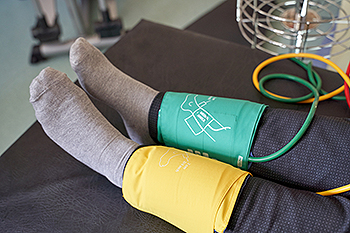 Peripheral artery disease (PAD), a condition that causes poor blood flow in the lower limbs, affects both men and women. After age 60, prevalence of PAD is higher in men than in women, yet women tend to be underdiagnosed and undertreated. This is because women are more likely to present with atypical symptoms, such as lower limb pain while exercising and while at rest. Many women present with no symptoms at all. For this reason, it is particularly important for women to undergo vascular testing to determine if they may have PAD. To learn more about this condition and get tested, schedule an appointment with a podiatrist near you.
Peripheral artery disease (PAD), a condition that causes poor blood flow in the lower limbs, affects both men and women. After age 60, prevalence of PAD is higher in men than in women, yet women tend to be underdiagnosed and undertreated. This is because women are more likely to present with atypical symptoms, such as lower limb pain while exercising and while at rest. Many women present with no symptoms at all. For this reason, it is particularly important for women to undergo vascular testing to determine if they may have PAD. To learn more about this condition and get tested, schedule an appointment with a podiatrist near you.
Peripheral artery disease can pose a serious risk to your health. It can increase the risk of stroke and heart attack. If you have symptoms of peripheral artery disease, consult with Dr. Richard T. Bauer from Summit Foot & Ankle. Our doctor will assess your condition and provide you with quality foot and ankle treatment.
Peripheral artery disease (PAD) is when arteries are constricted due to plaque (fatty deposits) build-up. This results in less blood flow to the legs and other extremities. The main cause of PAD is atherosclerosis, in which plaque builds up in the arteries.
Symptoms
Symptoms of PAD include:
- Claudication (leg pain from walking)
- Numbness in legs
- Decrease in growth of leg hair and toenails
- Paleness of the skin
- Erectile dysfunction
- Sores and wounds on legs and feet that won’t heal
- Coldness in one leg
It is important to note that a majority of individuals never show any symptoms of PAD.
Diagnosis
While PAD occurs in the legs and arteries, Podiatrists can diagnose PAD. Podiatrists utilize a test called an ankle-brachial index (ABI). An ABI test compares blood pressure in your arm to you ankle to see if any abnormality occurs. Ultrasound and imaging devices may also be used.
Treatment
Fortunately, lifestyle changes such as maintaining a healthy diet, exercising, managing cholesterol and blood sugar levels, and quitting smoking, can all treat PAD. Medications that prevent clots from occurring can be prescribed. Finally, in some cases, surgery may be recommended.
If you have any questions, please feel free to contact our office located in Latham, NY . We offer the newest diagnostic and treatment technologies for all your foot care needs.
